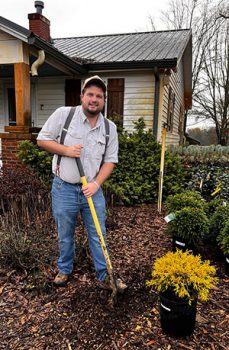
Nathan Wilson at work
When the Hall County Master Gardeners presented its Fall Symposium, the group included local nurseryman Nathan Wilson on the program. Wilson, operator of Lanier Nursery and Gardens, knows north Georgia gardening.
Although January and February bring temperatures that discourage working in the landscape, these months of “deep winter” offer many opportunities to start and/or improve your gardens for 2023.
When shrubs and trees are dormant, that’s the best time to install them in the landscape.
First, they can better develop their root system when the foliage isn’t competing for energy.
Second, water needs are reduced; yes, you still need to water, but the colder temperatures cut down on evaporation so you can water less frequently.
Third, plants will have a chance to settle in before they face the higher temperatures of summer.
“These are all good reasons to take advantage of winter plantings,” Wilson said. “Bundle up when you first get outdoors, but you’ll soon find that you’ll generate enough heat to peel off some of those layers. And it’s a good way to get off the couch and get moving.”
Wilson has boiled down home gardening success into three simple steps: design, proper planting and maintenance.
Here are his suggestions:
Design involves several aspects, including plant selection, location and light. “Choose plants that are native to our area, looking for a combination of colors of foliage and blossoms, where appropriate, that appeals to you,” he said. “Contrasting colors give a big bang for your buck, but also consider plants of different sizes, shapes and textures.”
Placement. Make sure you’re locating the plants in the best places for future growth. “A beautiful, native Serviceberry tree you bring home from the nursery is going to grow, so select a location that will allow it to do so. Don’t crowd these additions to your landscape. Read plant labels and research them on the internet to learn more about them.”
Light is crucial. Make sure you’re providing optimal light conditions, particularly in the summer. Again the plant labels yield good information.
When you’re planting, digging the proper sized hole is key. Dig the hole 2 to 3 times wider than the root ball or pot’s diameter. The depth should be about the height of the root ball or the soil level in the pot.
“Planting too deep can be harmful, covering up the vital feeder roots at the surface,” Wilson said. “Once the hole is dug, put some soft soil back on the bottom so that the plant’s soil level will be a half-inch to one inch above the ground. This allows for settling and helps the plant better access nutrients and water as it grows.
Break up any clods before backfilling the hole. “When planting trees and shrubs, soft soil from the hole is better than adding amendments, so that the roots will be reencouraged to grow out from the root ball into the surrounding ground,” he said.
Maintenance. It will keep your trees and shrubs happy and healthy.
“Once the shrub is established, usually within the first six to nine months of planting, water smartly,” he said. “Check the soil moisture before randomly watering. And when you water, water deeply but infrequently. Shallow frequent watering will discourage deep root growth.”
Pruning should be done when the plant is actively growing to allow the cuts to heal properly. “Also, use selective pruning rather than hedging, making random cuts at different levels inside the plant. Hedging results in poor plant health because it hinders air circulation and can stress the shrub or tree. A good guideline is to never prune more than one-fourth of the growth in a season.”
Mulch can be your friend. “A 2-inch layer of mulch, kept at least 2 inches away from the trunk, can help hold in moisture, prevent weeds and build organic matter in the soil.”
For more about native plants and proper gardening techniques, visit Lanier Nursery and Gardens at 4195 Schubert Rd. in Flowery Branch, visit the website at www.laniernurserygardens.com or call 470 290-5405.
Photo: by Pamela A. Keene





